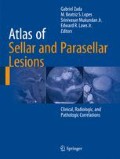Abstract
Gangliocytomas originating in the posterior pituitary are rare.
The majority of gangliocytomas of the neurohypophysis are actually a composite tumor with gangliocytic and pituitary adenomatous elements, forming so-called mixed gangliocytoma-pituitary adenomas.
The term “pituitary adenoma with adenohypophyseal neuronal choristoma” (PANCH) has also been used by some investigators, but it is discouraged by the current WHO classification.
Mixed gangliocytoma-pituitary adenomas are estimated to correspond to 0.5–1.25 % of all sellar region tumors.
Clinically, gangliocytomas present with hormonal oversecretion syndromes in 74 % of reported cases. These tumors are associated with neuroendocrine disorders, mainly acromegaly, although fewer cases with Cushing’s disease and hyperprolactinemia have been described.
Access this chapter
Tax calculation will be finalised at checkout
Purchases are for personal use only
References
Asa SL, Kovacs K, Tindall GT, Barrow DL, Horvath E, Vecsei P. Cushing’s disease associated with an intrasellar gangliocytoma producing corticotrophin-releasing factor. Ann Intern Med. 1984;101:789–93.
Horvath E, Kovacs K, Scheithauer BW, Lloyd RV, Smyth HS. Pituitary adenoma with neuronal choristoma (PANCH): composite lesion or lineage infidelity? Ultrastruct Pathol. 1994;18:565–74.
Kontogeorgos G, Mourouti G, Kyrodimou E, Liapi-Avgeri G, Parasi E. Ganglion cell containing pituitary adenomas: signs of neuronal differentiation in adenoma cells. Acta Neuropathol. 2006;112:21–8.
Kurosaki M, Saeger W, Ludecke DK. Intrasellar gangliocytomas associated with acromegaly. Brain Tumor Pathol. 2002;19:63–7.
Puchner MJ, Ludecke DK, Saeger W, Riedel M, Asa SL. Gangliocytomas of the sellar region--a review. Exp Clin Endocrinol Diabetes. 1995;103:129–49.
Baysefer A, Gezen F, Kayali H, Erdogan E, Timurkaynak E, Celasun B. Intrasellar gangliocytoma resembling pituitary adenoma. Minim Invasive Neurosurg. 1997;40:107–9.
Geddes JF, Jansen GH, Robinson SF, Gomori E, Holton JL, Monson JP, et al. ‘Gangliocytomas’ of the pituitary: a heterogeneous group of lesions with differing histogenesis. Am J Surg Pathol. 2000;24:607–13.
Saeger W, Puchner MJ, Ludecke DK. Combined sellar gangliocytoma and pituitary adenoma in acromegaly or Cushing’s disease. A report of 3 cases. Virchows Arch. 1994;425:93–9.
Towfighi J, Salam MM, McLendon RE, Powers S, Page RB. Ganglion cell-containing tumors of the pituitary gland. Arch Pathol Lab Med. 1996;120:369–77.
Saeger W, Ludecke DK, Buchfelder M, Fahlbusch R, Quabbe HJ, Petersenn S. Pathohistological classification of pituitary tumors: 10 years of experience with the German Pituitary Tumor Registry. Eur J Endocrinol. 2007;156:203–16.
Saeger W, Ludecke DK, Losa M. Combined neuronal and endocrine tumors of the sellar region. Pathologe. 1997;18:419–24.
Scheithauer BW, Silva AI, Parisi JE, Kovacs K, Horvath E. Ganglioglioma of the neurohypophysis. Endocr Pathol. 2008;19:112–6.
Fehn M, Lohmann F, Ludecke DK, Rudorff KH, Saeger W. Ganglioglioma of the neurohypophysis with secretion of vasopressin. Exp Clin Endocrinol Diabetes. 1998;106:425–30.
Mikami S, Kameyama K, Takahashi S, Yoshida K, Kawase T, Sano T, Mukai M. Combined gangliocytoma and prolactinoma of the pituitary gland. Endocr Pathol. 2008;19:117–21.
Jalali R, Deopujari CE, Bhutani R, Suhas U, Rajasekharan P, Kane SV, Gupta T. Suprasellar ganglioglioma with unusual diffuse involvement of the entire optico-chiasmal hypothalamic pathway. J Cancer Res Ther. 2008;4:140–3.
Asa SL, Scheithauer BW, Bilbao JM, Horvath E, Ryan N, Kovacs K, et al. A case for hypothalamic acromegaly: a clinicopathological study of six patients with hypothalamic gangliocytomas producing growth hormone-releasing factor. J Clin Endocrinol Metab. 1984;58:796–803.
Sy J, Ang LC. Cytomorphologic spectrum of mixed pituitary adenoma-gangliocytomas: a report of two cases. Acta Cytol. 2010;54:981–4.
McCowen KC, Glickman JN, Black PM, Zervas NT, Lidov HG, Garber JR. Gangliocytoma masquerading as a prolactinoma. Case report. J Neurosurg. 1999;91:490–5.
Serri O, Berthelet F, Belair M, Vallette S, Asa SL. An unusual association of a sellar gangliocytoma with a prolactinoma. Pituitary. 2008;11:85–7.
Puchner MJ, Ludecke DK, Valdueza JM, Saeger W, Willig RP, Stalla GK, Odink RJ. Cushing’s disease in a child caused by a corticotropin-releasing hormone-secreting intrasellar gangliocytoma associated with an adrenocorticotropic hormone-secreting pituitary adenoma. Neurosurgery. 1993;33:920–4; discussion 924–5.
Chen J, Hersmus N, Van Duppen V, Caesens P, Denef C, Vankelecom H. The adult pituitary contains a cell population displaying stem/progenitor cell and early embryonic characteristics. Endocrinology. 2005;146:3985–98.
Vidal S, Horvath E, Kovacs K, Lloyd RV, Smyth HS. Reversible transdifferentiation: interconversion of somatotrophs and lactotrophs in pituitary hyperplasia. Mod Pathol. 2001;14:20–8.
Fischer EG, Morris JH, Kettyle WM. Intrasellar gangliocytoma and syndromes of pituitary hypersecretion. Case report. J Neurosurg. 1983;59:1071–5.
Morikawa M, Tamaki N, Kokunai T, Imai Y. Intrasellar pituitary gangliocyto-adenoma presenting with acromegaly: case report. Neurosurgery. 1997;40:611–4; discussion 614–5.
Compton JJ, Long term outcomes for low-grade intracranial ganglioglioma: 30 year experience from the mayo. Clinic J Nevrojury. 2012(5) 825–30.
Author information
Authors and Affiliations
Corresponding author
Editor information
Editors and Affiliations
Rights and permissions
Copyright information
© 2016 Springer International Publishing Switzerland
About this chapter
Cite this chapter
Zada, G., Lopes, M.B.S., Mukundan, S., Laws, E. (2016). Gangliocytoma and Ganglioglioma. In: Zada, G., Lopes, M., Mukundan Jr., S., Laws Jr., E. (eds) Atlas of Sellar and Parasellar Lesions. Springer, Cham. https://doi.org/10.1007/978-3-319-22855-6_42
Download citation
DOI: https://doi.org/10.1007/978-3-319-22855-6_42
Publisher Name: Springer, Cham
Print ISBN: 978-3-319-22854-9
Online ISBN: 978-3-319-22855-6
eBook Packages: MedicineMedicine (R0)

